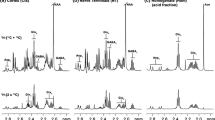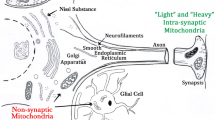Abstract
Mitochondrially bound brain hexokinase is solubilized by anesthetics and this effect has been suggested to contribute to anesthesia. In the present investigation the influence of the metabolic inhibitor 2-deoxy-D-glucose (2-DOG) was studied. An isolated rat brain preparation was used to avoid the contribution of peripheral reactions. Isolated rat brains were perfused for 45 min with media containing 4 mmol/l glucose, 10 mmol/l 2-DOG and/or 0.4 mmol/l thiopental. The EEG was monitored and acetylcholine, 2-DOG and its 6-phosphate, as well as the intracellular distribution of hexokinase activity were determined in brain tissue. Soluble hexokinase activity in brain cortex was enhanced by 2-DOG, as also by thiopental, and even more pronounced by both drugs used together. Results from in vitro experiments suggest that solubilization of mitochondrial hexokinase after 2-DOG is mediated by intracellularly accumulated 2-DOG-6-phosphate. 2-DOG produced a significant impairment of neuronal activity, revealing EEG patterns similar to those caused by thiopental anesthesia. Cortical acetylcholine levels were elevated by 2-DOG, as well as by thiopental, and again both drugs showed an additive effect when used in combination. This effect which may be the result of an inhibition of acetylcholine release, was also detectable in mice in vivo after 5 g 2-DOG/kg i.p., whereas the same dose of 3-O-methylglucose had no effect. The results provide further evidence that mitochondrial hexokinase may be involved in the relationship between cerebral metabolism and brain function.
Similar content being viewed by others
References
Dirks, B., Hanke, J., Krieglstein, J., Stock, R., andWickop, G. 1980. Studies on the linkage of energy metabolism and neuronal activity in the isolated perfused rat brain. J. Neurochem. 35:311–317.
Rose, I. A., andWarms, J. V. B. 1967. Mitochondrial hexokinase: release, rebinding and location. J. Biol. Chem. 242:1635–1645.
Kropp, E. S., andWilson, J. E. 1970. Hexokinase binding sites on mitochondrial membranes. Biochem. Biophys. Res. Commun. 38:74–79.
Gots, R. E., andBessman, S. P. 1974. The functional compartmentation of mitochondrial hexokinase. Arch. Biochem. Biophys. 163:7–14.
Inui, M., andIshibashi, S. 1979. Functioning of mitochondria-bound hexokinase in rat brain in accordance with generation of ATP inside the organelle. J. Biochem. (Tokyo) 85:1151–1156.
Bielicki, L., andKrieglstein, J. 1977. Solubilization of brain mitochondrial hexokinase by thiopental. Naunyn-Schmiedeberg's Arch. Pharmacol. 298:61–65.
Bielicki, L., andKrieglstein, J. 1977. The effects of anesthesia on brain mitochondrial hexokinase. Naunyn-Schmiedeberg's Arch. Pharmacol. 298:229–233.
Hanke, J., Höfeler, H., Krieglstein, J., andWever, K. 1979. Influence of various lipophilic drugs on brain mitochondrial hexokinase. Naunyn-Schmiedeberg's Arch. Pharmacol. 307:171–176.
Krieglstein, J., Sperling, G., andTwietmeyer, G. 1981. Effects of thiopental on regulatory mechanisms of brain energy metabolism. Naunyn-Schmiedeberg's Arch. Pharmacol. 318:56–61.
Brown, J. 1962. Effects of 2-deoxyglucose on carbohydrate metabolism. Review of the literature and studies in the rat. Metabolism 11:1098–1112.
Bachelard, H. S. 1971. Specificity and kinetic properties of monosaccharide uptake into guinea pig cerebral cortex in vitro. J. Neurochem. 18:213–222.
Horton, R. W., Meldrum, B. S., andBachelard, H. S. 1973. Enzymic and cerebral metabolic effects of 2-deoxy-D-glucose. J. Neurochem. 21:507–520.
Jenden, D. J., andHanin, I. 1974. Gaschromatographic microestimation of choline and acetylcholine after N-demethylation by sodium benzenethiolate. Pages 135–150,in Hanin, I. (ed.), Choline and Acetylcholine. Handbook of Chemical Assay Methods, Raven Press, New York.
Andjus, R., Suhara, K., andSloviter, H. A. 1967. An isolated, perfused rat brain preparation, its spontaneous and stimulated activity. J. Appl. Physiol. 22:1033–1039.
Dirks, B., Krieglstein, J., Lind, H. H., Rieger, H., andSchütz, H. 1980. Fluorocarbon perfusion medium applied to the isolated rat brain. J. Pharmacol. Methods 4:95–108.
Glowinski, J., andIversen, L. L. 1966. Regional studies of catecholamines in the rat brain. J. Neurochem. 13:655–669.
Takahashi, R., andAprison, M. H. 1964. Acetylcholine content of discrete areas of the brain obtained by a near-freezing method. J. Neurochem. 11:887–898.
Wilson, J. E. 1968. Brain hexokinase. J. Biol. Chem. 243:3640–3647.
Knull, H. R., Taylor, W. F., andWells, W. W. 1973. Effects of energy metabolism on in vivo distribution of hexokinase. J. Biol. Chem. 248:5414–5417.
Blecher, M. A. 1961. A fluorometric method for the determination of 2-deoxy-glucose. Analyt. Biochem. 2:30–38.
Karlén, B., Lundgren, G., Nordgren, I., andHolmstedt, B. 1974. Ion-pair extraction and gas-phase analysis of acetylcholine and choline. Pages 163–179,in Hanin, I. (ed.), Choline and Acetylcholine. Handbook of Chemical Assay Methods, Raven Press, New York.
Hanin, I., andJenden, D. J. 1969. Estimation of choline esters in brain by a new gaschromatographic procedure. Biochem. Pharmacol. 18:837–845.
Kilbinger, H. 1973. Gaschromatographic estimation of acetylcholine in the rabbit heart using a nitrogen selective detector. J. Neurochem. 21:421–429.
Clauss, G., andEbner, H. 1972. Grundlagen der Statistik. Verlag Harri Deutsch, Frankfurt, Zürich.
Bruns, H., Krieglstein, J., andWever, K. 1978. Narkose und intrazelluläre Verteilung der Hexokinase. Anaesthesist 27:557–561.
Krieglstein, J., Schachtschabel, D. O., Wever, K., andWickop, G. 1981. Influence of thiopental on intracellular distribution of hexokinase activity in various tumor cells. Arzneimittel-Forsch. 31:121–123.
Meldrum, B. S., andHorton, R. W. 1973. Cerebral functional effects of 2-desoxy-d-glucose and 3-O-methylglucose in rhesus monkeys. Electroenceph. Clin. Neurophysiol. 35:59–66.
Blass, J. P., andGibson, G. E. 1979. Carbohydrates and acetylcholine synthesis: Implications for cognitive disorders. Pages 215–236,in Davis, K. L., andBerger, P. A. (eds.), Brain acetylcholine and Neuropsychiatric Disease, Plenum Press, New York.
Sethy, V. H. 1978. Effect of hypnotic and anxiolytic agents on regional concentration of acetylcholine in rat brain. Naunyn-Schmiedeberg's Arch. Pharmacol. 301:157–161.
Nordberg, A., andWahlström, G. 1977. Effects of long-term forced oral barbital administration on endogenous acetylcholine in different regions of rat brain. Europ. J. Pharmacol. 43:237–242.
Stavinoha, W. B., Weintraub, S. T., andModak, A. T.: The use of microwave heating to inactivate cholinesterase in the rat brain prior to analysis for acetylcholine. J. Neurochem. 20:361–371.
Nordberg, A., andSundwall, A. 1977. Effect of sodium pentobarbital on the apparent turnover of acetylcholine in different brain regions. Acta Physiol. Scand. 99:336–344.
Richter, J. A., andWaller, M. B. 1977. Effects of pentobarbital on the regulation of acetylcholine content and release in different regions of rat brain. Biochem. Pharmacol. 26:609–615.
Landau, B. R., andLubs, H. A. 1958. Animal responses to 2-deoxy-d-glucose administration. Proc. Soc. Exp. Biol. (New York) 99:124–127.
Lewis, L. D., Ljunggren, B., Ratcheson, R. A., andSiesjö, B. K. 1974. Cerebral energy state in insulin-induced hypoglycemia, related to blood glucose and to EEG. J. Neurochem. 23:673–679.
Feise, G., Kogure, K., Busto, R., Scheinberg, P., andReinmuth, O. M. 1976. Effects of insulin hypoglycemia upon cerebral energy metabolism and EEG activity in the rat. Brain Res. 126:263–280.
Gibson, G. E., andBlass, J. P. 1976. Impaired synthesis of acetylcholine in brain accompanying mild hypoxia and hypoglycemia. J. Neurochem. 27:37–42.
Stock, R., Krieglstein, J., andSperling, G. 1981. Effects of deoxy-d-glucose on intracellular distribution of hexokinase activity, EEG, and acetylcholine content in CNS. Naunyn-Schmiedeberg's Arch. Pharmacol. 376:R65.
Author information
Authors and Affiliations
Additional information
A preliminary report of these results has been made at the 22nd spring meeting of the Deutsche Pharmakologische Gesellschaft at Mainz (38).
Rights and permissions
About this article
Cite this article
Krieglstein, J., Sperling, G. & Stock, R. Relationship between brain mitochondrial hexokinase and neuronal function. Neurochem Res 7, 737–748 (1982). https://doi.org/10.1007/BF00965526
Accepted:
Issue Date:
DOI: https://doi.org/10.1007/BF00965526




